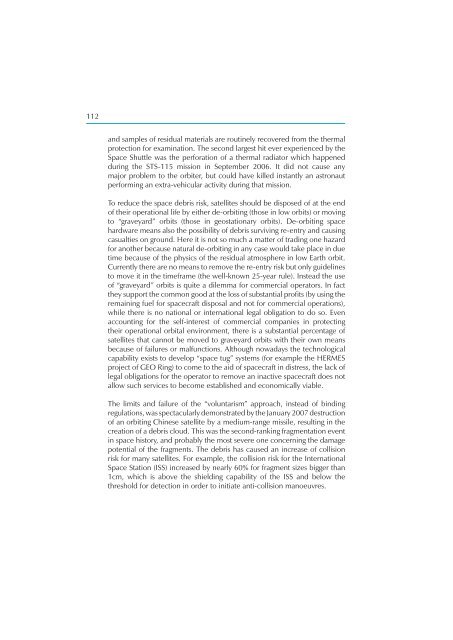Security in Space The Next Generation - UNIDIR
Security in Space The Next Generation - UNIDIR
Security in Space The Next Generation - UNIDIR
You also want an ePaper? Increase the reach of your titles
YUMPU automatically turns print PDFs into web optimized ePapers that Google loves.
112<br />
and samples of residual materials are rout<strong>in</strong>ely recovered from the thermal<br />
protection for exam<strong>in</strong>ation. <strong>The</strong> second largest hit ever experienced by the<br />
<strong>Space</strong> Shuttle was the perforation of a thermal radiator which happened<br />
dur<strong>in</strong>g the STS-115 mission <strong>in</strong> September 2006. It did not cause any<br />
major problem to the orbiter, but could have killed <strong>in</strong>stantly an astronaut<br />
perform<strong>in</strong>g an extra-vehicular activity dur<strong>in</strong>g that mission.<br />
To reduce the space debris risk, satellites should be disposed of at the end<br />
of their operational life by either de-orbit<strong>in</strong>g (those <strong>in</strong> low orbits) or mov<strong>in</strong>g<br />
to “graveyard” orbits (those <strong>in</strong> geostationary orbits). De-orbit<strong>in</strong>g space<br />
hardware means also the possibility of debris surviv<strong>in</strong>g re-entry and caus<strong>in</strong>g<br />
casualties on ground. Here it is not so much a matter of trad<strong>in</strong>g one hazard<br />
for another because natural de-orbit<strong>in</strong>g <strong>in</strong> any case would take place <strong>in</strong> due<br />
time because of the physics of the residual atmosphere <strong>in</strong> low Earth orbit.<br />
Currently there are no means to remove the re-entry risk but only guidel<strong>in</strong>es<br />
to move it <strong>in</strong> the timeframe (the well-known 25-year rule). Instead the use<br />
of “graveyard” orbits is quite a dilemma for commercial operators. In fact<br />
they support the common good at the loss of substantial profi ts (by us<strong>in</strong>g the<br />
rema<strong>in</strong><strong>in</strong>g fuel for spacecraft disposal and not for commercial operations),<br />
while there is no national or <strong>in</strong>ternational legal obligation to do so. Even<br />
account<strong>in</strong>g for the self-<strong>in</strong>terest of commercial companies <strong>in</strong> protect<strong>in</strong>g<br />
their operational orbital environment, there is a substantial percentage of<br />
satellites that cannot be moved to graveyard orbits with their own means<br />
because of failures or malfunctions. Although nowadays the technological<br />
capability exists to develop “space tug” systems (for example the HERMES<br />
project of GEO R<strong>in</strong>g) to come to the aid of spacecraft <strong>in</strong> distress, the lack of<br />
legal obligations for the operator to remove an <strong>in</strong>active spacecraft does not<br />
allow such services to become established and economically viable.<br />
<strong>The</strong> limits and failure of the “voluntarism” approach, <strong>in</strong>stead of b<strong>in</strong>d<strong>in</strong>g<br />
regulations, was spectacularly demonstrated by the January 2007 destruction<br />
of an orbit<strong>in</strong>g Ch<strong>in</strong>ese satellite by a medium-range missile, result<strong>in</strong>g <strong>in</strong> the<br />
creation of a debris cloud. This was the second-rank<strong>in</strong>g fragmentation event<br />
<strong>in</strong> space history, and probably the most severe one concern<strong>in</strong>g the damage<br />
potential of the fragments. <strong>The</strong> debris has caused an <strong>in</strong>crease of collision<br />
risk for many satellites. For example, the collision risk for the International<br />
<strong>Space</strong> Station (ISS) <strong>in</strong>creased by nearly 60% for fragment sizes bigger than<br />
1cm, which is above the shield<strong>in</strong>g capability of the ISS and below the<br />
threshold for detection <strong>in</strong> order to <strong>in</strong>itiate anti-collision manoeuvres.








